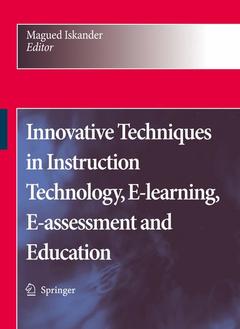Innovative Techniques in Instruction Technology, E-learning, E-assessment and Education, Softcover reprint of hardcover 1st ed. 2008
Coordonnateur : Iskander Magued

Innovative Techniques in Instruction Technology, E-Learning, E-Assessment and Education is a collection of world-class paper articles addressing the following topics: (1) E-Learning including development of courses and systems for technical and liberal studies programs; online laboratories; intelligent testing using fuzzy logic; evaluation of on line courses in comparison to traditional courses; mediation in virtual environments; and methods for speaker verification. (2) Instruction Technology including internet textbooks; pedagogy-oriented markup languages; graphic design possibilities; open source classroom management software; automatic email response systems; tablet-pcs; personalization using web mining technology; intelligent digital chalkboards; virtual room concepts for cooperative scientific work; and network technologies, management, and architecture. (3) Science and Engineering Research Assessment Methods including assessment of K-12 and university level programs; adaptive assessments; auto assessments; assessment of virtual environments and e-learning. (4) Engineering and Technical Education including cap stone and case study course design; virtual laboratories; bioinformatics; robotics; metallurgy; building information modeling; statistical mechanics; thermodynamics; information technology; occupational stress and stress prevention; web enhanced courses; and promoting engineering careers. (5) Pedagogy including benchmarking; group-learning; active learning; teaching of multiple subjects together; ontology; and knowledge representation. (6) Issues in K-12 Education including 3D virtual learning environment for children; e-learning tools for children; game playing and systems thinking; and tools to learn how to write foreign languages.
All communications between the authors, reviewers, and conference organizing committee were done online, which permitted a short six week period from the paper submission deadline to the beginning of the conference
PowerPoint presentations, final paper manuscripts were available to registrants for three weeks prior to the start of the conference.
The conference platform allowed live presentations by several presenters from different locations, with the audio and PowerPoint transmitted to attendees through the internet, even on dial up connections
Attendees were able to ask both audio and written questions in a chat room format, and presenters could mark up their slides as they deemed fit
The live audio presentations were also recorded and distributed to participants along with the PowerPoint presentations and paper manuscripts within the conference DVD
Date de parution : 11-2010
Ouvrage de 601 p.
19.3x26 cm
Disponible chez l'éditeur (délai d'approvisionnement : 15 jours).
Prix indicatif 210,99 €
Ajouter au panierDate de parution : 09-2008
Ouvrage de 601 p.
17.8x25.4 cm
Thèmes d’Innovative Techniques in Instruction Technology... :
Mots-clés :
NOVICE; Open Source; Processing; Scala; Unified Modeling Language (UML); Usability; Web; algorithms; blog; e-learning; learning object; modeling; tablet; tools
